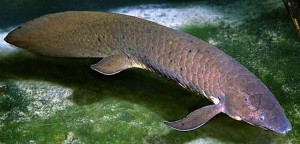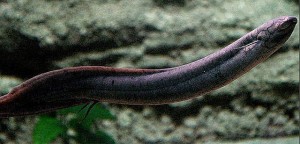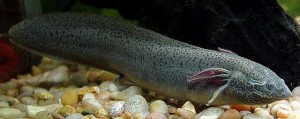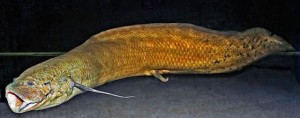Lungfish is the generic name given to a group of fish belonging to the families Ceratodontidae, Lepidosirenidae and Protopteridae. Each family represents a different continent where they can be found specifically, Australia, South America, and Africa.
Lungfish get their name from the fact that they can breed atmospheric oxygen by using lungs similar to those found in early amphibians. This adaptation allows them to survive out of the water and in waters with very low oxygen content.
All lungfish are freshwater fish that belong to the subclass Dipnoi, and all have modified swim bladders or “lungs” that allow them to absorb oxygen and remove wastes.
The African and South American species all have two lungs and are able to burrow into the mud and secrete a mucous lined burrow where they can survive out of water for quite some time. They are able to dramatically reduce their metabolic rate and breathe air through their swim bladder instead of their gills. If kept underwater, these lungfish will actually drown if they are not able to surface for a gulp of air.
The Australian lungfish (Neoceratodus forsteri) is the largest, most primitive species, and has only one lung. Unlike their African and South American counterparts, they can survive out of water for prolonged periods if they are kept moist. Although they can breathe air using their “lungs” when out of the water, they cannot survive complete desiccation like their African and South American cousins.
Neoceratodus forsteri is native to the Mary and Burnett River systems in Western Australia and is protected under CITES. It is rarely seen in the aquarium hobby by tropical fish keeping enthusiasts.
The African and South American lungfish have adapted to survival when the pools of water that they normally live in evaporate during the dry seasons. They are able to burrow into the mud and seal themselves into a mucous lined capsule or burrow, until the rainy season restores their natural habitat.
Changes in their physiology allow them to slow down their metabolism to as slow as 1/60th of their normal rate. Normally, lungfish excrete nitrogenous waste as ammonia directly into the water, but during the time they are in their “cocoons”, protein wastes are converted from ammonia to less toxic urea.
Australian lungfish are also known as the Queensland lungfish and can be distinguished from other lungfishes by their large scales and flipper like fins. This species is extremely long lived and grow much larger than other lungfish.
South American and African lungfish have slender, ropelike fins, and much smaller scales.
All species of lungfish are omnivores that have an intestinal spiral valve instead of a true stomach. In their natural habitats they feed on fish, insects, crustaceans, amphibians, worms, mollusks, plant matter and just about anything they can fit into their mouths.
As juvenile lungfish develop into adults, their teeth fuse together to form tooth plates which they use to chew their food.
The chart below depicts the three families and six species of lungfish known today. Four of the species are found in Africa (Protopteridae), one in Australia (Ceratodontidae), and one in South America (Lepidosirenidae).
Extant lungfishes
Australian lungfish (Neoceratodus forsteri) is considered to be the most primitive species, with the African and South American species being more closely related.
As their name suggests, members of this group possess either one lung (Ceratodontiformes), or two lungs (Lepidosireniformes) which are used to breathe atmospheric oxygen.
All juvenile lungfish possess external gills which (in most species) are lost as the fish develops into adulthood. Members of Lepidosireniformes (South American and African) are all capable of estivation; a state of dormancy and low metabolism during periods of desiccation.
All species of lungfishes are predators and can grow very large in an aquarium environment.
Depending on the species, lungfish can grow from 4 to 6 1/2 feet in length and are only suitable for a single species tank. They require a large tank of at least 100 gallons with a fine gravel or sandy substrate, some driftwood and smooth rocks for hiding places, and some plants for aesthetics. They are tolerant of water conditions but prefer neutral to slightly acidic water. Avoid sharp rocks that could damage them and any fish that could fit into their mouths.
Captive lungfish are extremely easy to feed. They will literally eat just about anything that they can fit into their mouth. Shrimp, fish, crawdads, crabs, meat (except pork), worms, and even omnivore pellets will keep them happy.
Except for the fact that they can be bred in ponds, little is known about the breeding habits of lungfish in an aquarium environment.
Lepidosirenidae builds nests to deposit their eggs which are guarded by the males until hatched out. The young have gills and spend their first few weeks hiding among dense vegetation. It is believed that the secret to breeding lungfish in an aquarium environment is to mimic the rainy season in their natural habitat.
Australian lungfish do not build nests. They deposit their eggs on the bottom of the pond where they hatch out after about three weeks or so. The young are said to grow very slowly, probably due to the longevity of this species. One Australian lungfish has been housed in the Shedd Aquarium in Chicago since 1933.
African and South American lungfish are available to tropical fish keeping enthusiasts on a semi regular basis and are moderately priced according to size.
The Australian lungfish is CITES protected but occasionally available to the trade through licensed breeders. They are usually very expensive ($800.00) for a single specimen and considerably more for albino specimens.








